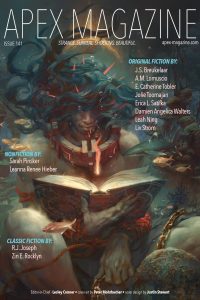Paul Di Filippo reviews Hari Kunzru
 Experienced genre readers approaching the mere title of Hari Kunzru’s new slipstream novel, Gods Without Men, will surely flash upon an old riff of fantastika: those deities who lose human worshippers and are deprived of prayers and fear and respect and adoration will dwindle away in power and status, until finally they are rendered mortal or disappear entirely. The resonance of this old trope with Kunzru’s book is not entirely amiss, since his core topic is the changing nature of the forces we honor with our reverence. But this book is no simplistic American Gods imitation.
Experienced genre readers approaching the mere title of Hari Kunzru’s new slipstream novel, Gods Without Men, will surely flash upon an old riff of fantastika: those deities who lose human worshippers and are deprived of prayers and fear and respect and adoration will dwindle away in power and status, until finally they are rendered mortal or disappear entirely. The resonance of this old trope with Kunzru’s book is not entirely amiss, since his core topic is the changing nature of the forces we honor with our reverence. But this book is no simplistic American Gods imitation.
Kunzru actually derives his title from a Balzac quotation with a different import: “In the desert, you see, there is everything and nothing… It is God without men.” So now one starts thinking immediately along the lines of Luis Buñuel’s trippy Simon of the Desert or Rudy Wurlitzer’s Flats.
We are promised a look into the whirlpool of sheer divinity, the alpha and omega of the numinous. And Kunzru’s sky-aspiring, hypnotic, clever and compassionate tale does truly concern itself with the birth of new gods out of the sere places of the imagination, and their tangled relationships with their mortal acolytes. Think Ellison’s “Paingod” and “The Deathbird.”
But in addition, Kunzru sets himself the high artistic challenge of seeing if he can use what are possibly the most culturally debased quasi-religious materials in the contemporary landscape for the fashioning of his narrative. By this, I refer to UFO/Ancient Astronaut/New Age beliefs. He deliberately puts himself in the arena described by William Gibson in “The Winter Market.”
“Rubin, in some way that no one quite understands, is a master, a teacher, what the Japanese call a sensei. What he’s the master of, really, is garbage, kipple, refuse, the sea of cast-off goods our century floats on. Gomi no sensei. Master of junk.”
In an allied vein, Phil Dick’s VALIS-inspired recastings of the quotidian into epiphanical icons comes into play.
Every reader of SF has, I’m sure, at one time or another, after cautiously revealing one’s reading tastes to a mundane interlocutor, been asked if such literary folly also entails a belief in “flying saucers” or “alien-constructed Stonehenge” or “indigo children.” This expansive cohort of wacky, contrived superstitions, whose roots actually predate commercial SF, arising out of the Spiritualism movement of the 1840s, has long been inextricably bound up in the mass mind with speculative fiction and heroic fantasy and horror. Surely, any reader of Tolkien must endorse Deepak Chopra. If you read Stephen King, you must believe in Amityville. And if you like Clarke or Asimov, you must dig von Däniken!
In a deliberate attempt to mine this rubbish tip of dumb ideas for nuggets of psychological gold—much in the manner that Carl Jung seriously examined UFO beliefs for deep-rooted significance—Kunzru assembles a beautifully limned cast of characters across two centuries of jumbled time, and binds them together with desert-bred visions.
After a little Native American Coyote fable, in which Coyote has some trouble while cooking crystal meth, we begin in 1947, the pivotal year for UFOs, with a damaged fellow named Schmidt, who sets up housekeeping at the Pinnacles, a mystical Southwestern rock formation which of course will conjure up notions of Close Encounters. Schmidt has engineered a gadget to broadcast etheric messages, and at the close of his first chapter, he seems to get an answer. Subsequent chapters show him in the 1950s leading a successful cult at the Pinnacles, and then vanished by 1969, with the cult in shambles. We also see the region from the perspective of the 1700s and 1920, and from outsider vantages such as that of Laila, a young Iraqi immigrant.
But what feels like the main armature of the narrative, given its preponderance of pages, are the events of 2008, when an unhappy family—Jaz, Lisa, and their autistic son Raj—end up in the vicinity of the Pinnacles, coincidentally along with a burnt-out rock musician named Nicky Capaldi. We inhabit the plight of the besieged parents and their disabled child intimately from within their daily grief, and when something mysterious and seemingly bad happens to Raj, we go with them into a deeper tabloid hell. (Ian McEwan fans might at this juncture have cause to think of his novel, The Child in Time.) Eventually, all the strands of the book braid into a tight rope of synchronicity, whose exact contours are multivalent and in flux.
Kunzru is unabashed about using the crappiest sub-Whitley-Strieber locutions of his UFOnauts: “This is the voice of the Ashtar Galactic Command. We speak in the names of all sentient beings in the thirty-three sectors of the Universe, in the names of the ascended Masters and the Conclave of Interdimensional Unity.” But he successfully transubstantiates all this drivel, providing the same frisson one would get if it turned out all the Ray Palmer/Shaver Mystery stuff proved to be divine text.
Ultimately, Kunzru’s involving story affirms that we cannot afford to discard any avenue of divinity. In this age of overhyped Burning Man festivals and Rainbow Family gatherings, the door to heaven might indeed be hiding inside some slacker’s homemade teepee.








Pingback:SF Tidbits for 3/26/12 - SF Signal – A Speculative Fiction Blog